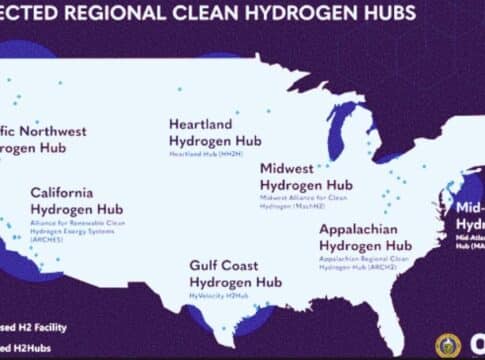Startup Revolutionizes Mobility Sector with World’s First Carbon Credit Patent
A pioneering climate tech company, Greenlines Technology, announced the approval of the world’s first carbon credit generation process patent awarded by the United States Patent and Trademark Office (USPTO).
Greenlines Technology empowers and rewards sustainable behaviour in the mobility and e-commerce industries to make a positive environmental impact through its advanced digital measurement, reporting, and verification (dMRV) technology.
The Vancouver-based climate tech startup is the first to coin the term ‘Human-based Solutions’ (HbS) in carbon markets, which refers to contributions by individuals and their behavior in reducing carbon emissions.
Greenlines: Pioneer Carbon Credit Patent in Transportation
The first-of-its-kind patent, Mobility Carbon Engine (MCE), represents a significant advancement in global carbon markets, providing novel intellectual property rights. Titled “Methods and Systems for Conversion of Physical Movements to Carbon Units”, it has Patent Number US 11,774,255 B2.
Greenlines’ landmark patent enables mobility app owners to measure and monetize emission reductions facilitated by users. The groundbreaking technology can accurately calculate and monetize those reductions, setting a precedent for quantifying sustainable transportation impacts.
The newly patented technology has been around since 2019 in 60+ cities across Canada and the U.S.
Highlighting the importance of this technology in reducing emissions and promoting sustainability in mobility, CEO and co-founder David Oliver noted:
“By providing a systematic approach to accurately quantify and recognize emission reductions resulting from individuals’ use of low-carbon land, water, and air-based transportation modes, the MCETM creates a comprehensive framework that rewards individuals and organizations for choosing sustainable alternatives.”
As per the Environmental Protection Agency’s latest data, greenhouse gas (GHG) emissions from transportation account for about 29% of total U.S. emissions, making it the biggest contributor of the country’s pollution.
With over a third of Americans commuting to work on an average of 44 km or 27 miles, the annual CO2 emissions per commuter stands at about 4.6 tons.
According to Oliver, if 10% of these commuters use their MCE, it can potentially slash their emissions by around 20%. That’s equivalent to a total of 24 million tons of CO2 emission reductions each year in the US transport sector.
RELATED: Public Transportation Pricing Schemes Can Cut Emissions
MCE Transforms the Transportation Sector
The MCE is powered by Greenlines proprietary Modal Shift Optimization GHG Quantification Methodology developed according to ISO 14064-2. This guarantees that the carbon credits generated through the app meet the highest standards and trades at a premium price.
The technology uses advanced algorithms to measure the emission reductions from each trip, avoiding reversal and ensuring offsets are permanent. It is simple to use and has a user-friendly interface, thus it is highly accessible to everyone.
To meet the criterion on additionality, the MCE creates a custom baseline for each user and use it as reference for getting the emission reductions. The reduction is the difference between the baseline and the actual carbon pollution emitted by each trip. The data is crucial to ensure that the reductions are additional compared to the emissions without the offset project.
In establishing the baseline, Greenlines uses regional project and baseline emissions for various transportation modes – land, water, and air. These include taxis, public transit, ride-hailing, e-scooters, and pedal bikes.
The innovative technology employs a robust monitoring system to track and verify the emission reductions. Verification is through independent, third-party verifier. And these verified emission reductions (VERs) have been successfully sold as carbon credits to voluntary buyers in the carbon market.
Greenlines’ carbon offset project is transparent with publicly accessible information, including the amount of CO2 reduced, the MRV process, and offset revenue use.
Meeting all these criteria – additional, permanent, real, verifiable, and transparent – makes the carbon credits or offsets generated of high-quality. Each credit represents a tonne of reduced CO2 emissions.
Greenlines’ technology offers a potential to revolutionize the mobility sector while providing a strong incentive for individuals to choose low-carbon trips. It empowers mobility aggregators, including transit agencies, trip planning apps, and private mobility providers to promote sustainable transportation practices.
RELATED: Google Earth Engine – Open for Business
Incentivizing Sustainable Behavior with Carbon Credits
The patent doesn’t only track and monetize emissions from personal trips but also from food and package deliveries, Oliver said.
That’s through their upcoming E-commerce Carbon Engine (ECE), which is currently in its pilot phase. Same as MCE, ECE will also generate carbon credits from low-carbon items bought in e-commerce or online trading platforms.
ECE uses Greenlines’ proprietary algorithms to get the CO2 footprint of each product, allowing consumers to choose low-carbon purchases. Thus, it also has the potential to slash emissions of online shopping.
Greenlines had already implemented the MCE technology across various North American cities. But it also plans to expand its reach globally by initiating patent applications in other jurisdictions such as the EU.
Their goal is to incentivize and drive sustainable practices worldwide through carbon credits generated by their patented technology.
By combining innovative technology with sustainability, Greenlines revolutionizes carbon markets while giving commuters the opportunity to identify, quantify, and monetize their carbon emissions reductions.
The post Startup Revolutionizes Mobility Sector with World’s First Carbon Credit Patent appeared first on Carbon Credits.



